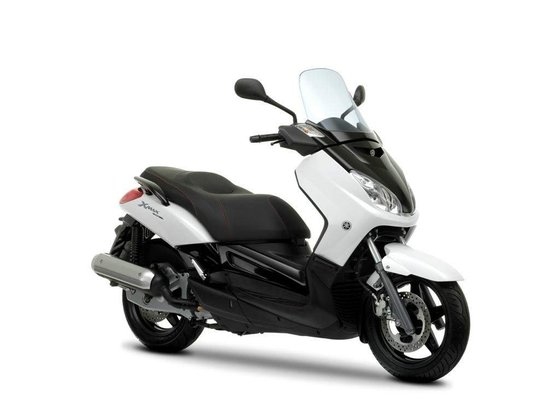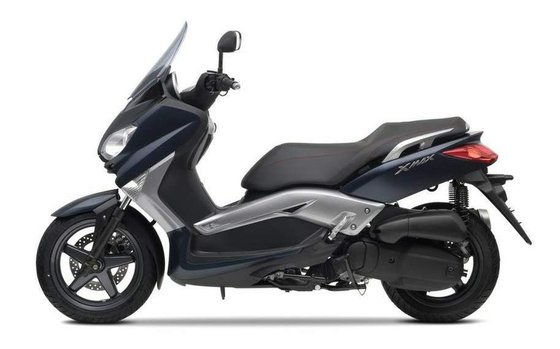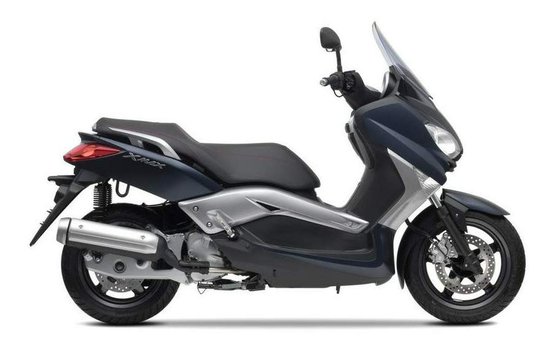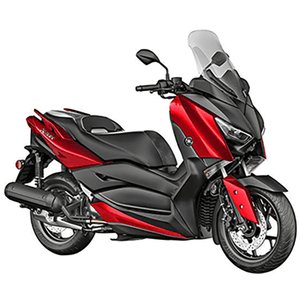Yamaha YP 125 R X Max (2006-2009): The Urban Gladiator That Still Commutes With Style

Introduction
The Yamaha XMAX 125 remains one of the most intriguing propositions in the 125cc scooter segment. Produced between 2006 and 2009, this generation carved out a niche by blending sporty aesthetics with commuter practicality. While modern scooters chase minimalist trends, the XMAX 125 of this era feels like a time capsule of Yamaha's bold design philosophy – a machine that refuses to fade into anonymity. After spending a week weaving through city traffic and open roads, it's clear why this scooter still commands respect among urban riders.
Design & Ergonomics: Sharp Lines Meets Function

The XMAX 125 doesn’t just sit in traffic – it owns it. Yamaha’s designers injected a dose of TMAX DNA into this smaller sibling, evident in the aggressive front cowling and angular bodywork. The single-piece cowling isn’t just for show; it channels airflow efficiently, keeping rain off your knees and providing surprising wind protection at 80 km/h (50 mph).
The cockpit feels premium for its class. The rev counter (a rare feature in 125cc scooters) sits proudly beside the digital speedometer, both bathed in red backlighting that’s easy on night rides. The 785 mm (30.9") seat height accommodates riders from 160 cm (5'3") upwards, though taller riders will appreciate the flat footboard that lets you stretch out during long commutes.
Storage? Yamaha played chess here. The underseat compartment swallows two full-face helmets – a party trick that still embarrasses newer rivals. The lockable glovebox (large enough for a 1.5L water bottle) and optional top case compatibility make this a grocery-getting champion.
Engine & Performance: Small Bore, Big Heart

Don’t let the 124.7cc displacement fool you. The liquid-cooled, fuel-injected single cylinder is a masterpiece of urban tuning. With 13.8 HP peaking at 8,750 RPM and 11.33 Nm (8.4 lb-ft) of torque at 6,500 RPM, it’s optimized for stoplight dashes rather than highway sprints.
Twist the throttle from standstill, and the CVT transmission delivers smooth acceleration up to its governed top speed of 105 km/h (65 mph). It’s happiest between 50-80 km/h (31-50 mph), where the engine hums at 6,000-7,000 RPM without vibration intrusion. Fuel efficiency shines – expect 35-40 km/l (82-94 mpg) in mixed riding, translating to 440-500 km (273-310 miles) from the 12.5L (3.3 gal) tank.
The real surprise is engine braking. Close the throttle at 70 km/h (43 mph), and deceleration feels positively motorcycle-like – a boon for aggressive urban riders who despise relying solely on brakes.
Ride Experience: Dance Between Stability and Agility

Yamaha’s chassis engineers deserve applause. The 1545 mm (60.8") wheelbase and 153 kg (337 lbs) dry weight create a paradox – stable enough for windy days yet flickable in traffic. The 15-inch front and 14-inch rear wheels (unusual in today’s scooter world of smaller rims) contribute to this magic, rolling over potholes that would jar smaller setups.
Suspension leans toward the firmer side. The telescopic fork (110 mm/4.3" travel) and rear swingarm (95 mm/3.7") handle sharp bumps competently, though expansion joints at speed will remind you this isn’t a luxury tourer. Push hard into corners, and the IRC tires (120/70-15 front, 140/70-14 rear) provide reassuring grip, though upgrading to modern rubber like Michelin City Grip 2s transforms wet-weather confidence.
Braking is adequate but demands respect. The 267mm front disc (single-piston caliper) and 240mm rear disc require a firm squeeze during emergency stops. Swapping to sintered pads and braided lines – both available at MOTOPARTS.store – elevates performance to modern standards.
Competition: How It Stacks Up Against Rivals
The 2006-2009 XMAX 125 faced stiff competition, and understanding its place helps modern buyers evaluate used purchases:
- Honda SH125
- Pros: Lighter (144 kg/317 lbs), taller 16" wheels for better pothole absorption
- Cons: Carbureted until 2007, smaller storage, bland styling
-
XMAX Edge: Fuel injection from day one, sportier ergonomics, superior weather protection
-
Suzuki Burgman 125
- Pros: More luxurious seating, electric screen (on higher trims)
- Cons: Heavier (166 kg/366 lbs), complex bodywork raises repair costs
-
XMAX Edge: Simpler mechanics, better power-to-weight ratio, lower seat height
-
Aprilia Scarabeo 125
- Pros: Italian flair, larger 16" wheels
- Cons: Spotty reliability, cramped footboard
- XMAX Edge: Yamaha’s bulletproof reliability, storage capacity
For riders today, the XMAX 125’s fuel injection and storage make it a smarter used buy than carbureted contemporaries. Its parts commonality with later models (until 2023) also ensures aftersupport longevity.
Maintenance: Keeping Your XMAX 125 Battle-Ready

Owning a 15-year-old scooter demands vigilance. Here’s what to prioritize:
-
Belt & Rollers
The factory belt lasts ~20,000 km (12,427 miles), but aged examples need immediate inspection. MOTOPARTS.store stocks OEM-spec Kevlar-reinforced belts and 18g roller weights for smoother acceleration. -
Cooling System
Flush coolant every 2 years using ethylene glycol mix. Watch for crusty residue around the water pump (under the left crankcase cover) – a sign of impending seal failure. -
Valve Adjustments
Strictly follow the 4,000 km (2,485 mi) interval: - Intake: 0.10-0.14 mm (0.004-0.006")
-
Exhaust: 0.22-0.26 mm (0.009-0.010")
Neglect causes hard starting and power loss. -
Tire Upgrades
Modern radial tires improve handling dramatically. Pair 120/70-15 front and 140/70-14 rear tires for best results – we recommend Pirelli Diablo Rosso Scooter for aggressive riders. -
Brake Revival
Old DOT 4 fluid absorbs moisture – flush annually. Consider EBC HH sintered pads and stainless lines for sharper lever feel. -
Electrical TLC
The ECU is robust, but check the stator coils (common failure point) if charging voltage drops below 13.8V at 3,000 RPM.
Conclusion: Timeless, But Ready for Your Touch
The 2006-2009 Yamaha XMAX 125 ages like a rebellious rockstar – slightly rough around the edges but oozing character missing from today’s homogenized scooters. It’s a canvas waiting for your personalization: lower the gearing with a 15-tooth front pulley for zippier starts, add a taller windscreen for highway comfort, or install LED aux lights for nocturnal adventures.
At MOTOPARTS.store, we’ve curated everything from performance upgrades to OEM-style replacements. Whether you’re reviving a neglected gem or optimizing a well-loved workhorse, this XMAX generation rewards those who treat it as more than mere transportation – it’s urban motorcycling distilled to its purest, most addictive form.
Specifications sheet
| Engine | |
|---|---|
| Stroke: | Four-stroke |
| Max power: | 10 kW | 13.0 hp |
| Max torque: | 11 Nm |
| Fuel system: | Fuel Injection |
| Lubrication: | Wet sump |
| Max power @: | 8750 rpm |
| Displacement: | 125 ccm |
| Max torque @: | 6500 rpm |
| Bore x Stroke: | 52 x 58.6 mm (2.0 x 2.3 in) |
| Configuration: | Single |
| Cooling System: | Liquid cooled |
| Compression ratio: | 11.2:1 |
| Number of cylinders: | 1 |
| Dimensions | |
|---|---|
| Wheelbase: | 1545 mm (60.8 in) |
| Dry weight: | 153 |
| Wet weight: | 166 |
| Seat height: | 785 mm (30.9 in) |
| Overall width: | 790 mm (31.1 in) |
| Overall height: | 1385 mm (54.5 in) |
| Overall length: | 2210 mm (87.0 in) |
| Ground clearance: | 113 mm (4.4 in) |
| Fuel tank capacity: | 12.5 L (3.3 US gal) |
| Drivetrain | |
|---|---|
| Final drive: | belt |
| Transmission: | Automatic CVT |
| Maintainance | |
|---|---|
| Engine oil: | 10W40 |
| Idle speed: | 1600–1800 rpm |
| Break fluid: | DOT 4 |
| Spark plugs: | NGK CPR9EA-9 |
| Spark plug gap: | 0.9 |
| Final drive oil: | 210 ml SAE 10W-30 |
| Coolant capacity: | 1.0 |
| Forks oil capacity: | 0.36 |
| Rear tire pressure: | 2.5 bar (36 psi) |
| Engine oil capacity: | 1.5 |
| Front tire pressure: | 2.1 bar (30 psi) |
| Valve clearance (intake, cold): | 0.10–0.14 mm |
| Valve clearance (exhaust, cold): | 0.22–0.26 mm |
| Additional Features | |
|---|---|
| Instrumentation: | Red backlit analogue/digital dashboard |
| Storage capacity: | Two full-face helmets |
| Standard features: | ['Lockable glove compartment', 'ABS (some models)', 'Electric start'] |



















